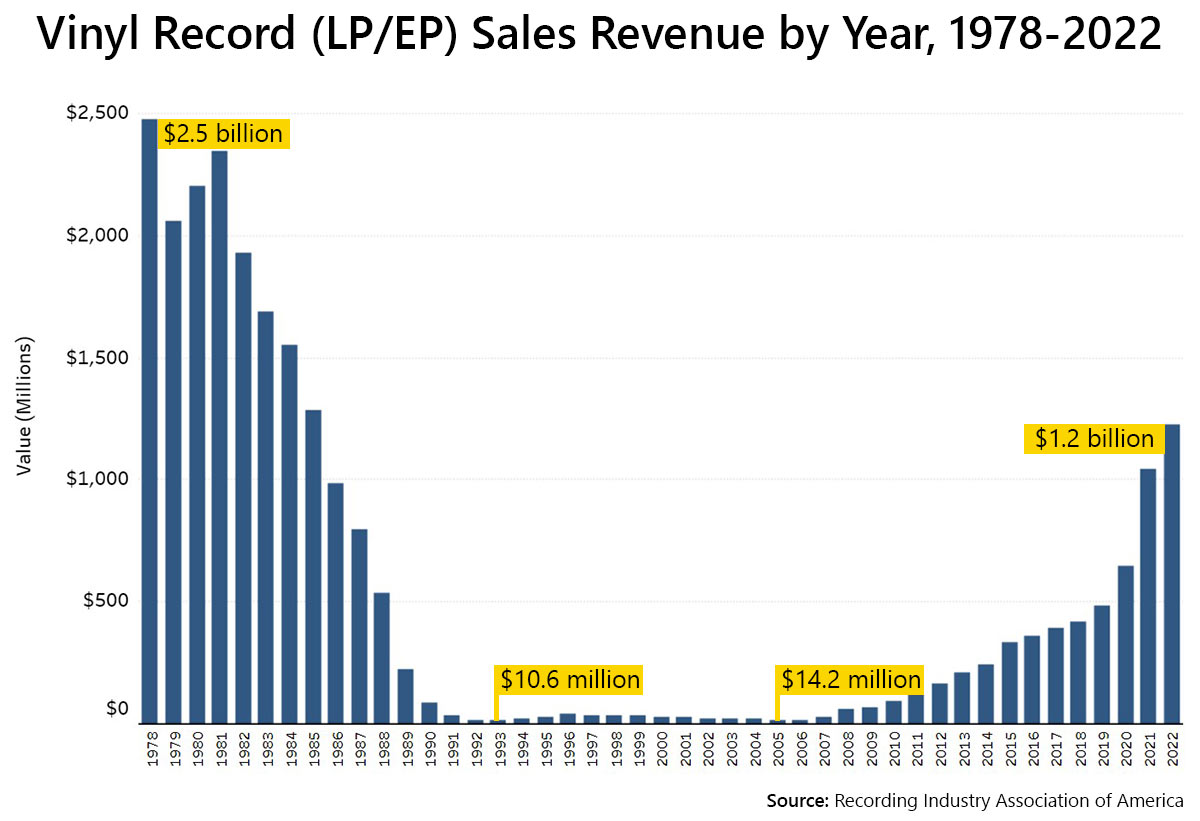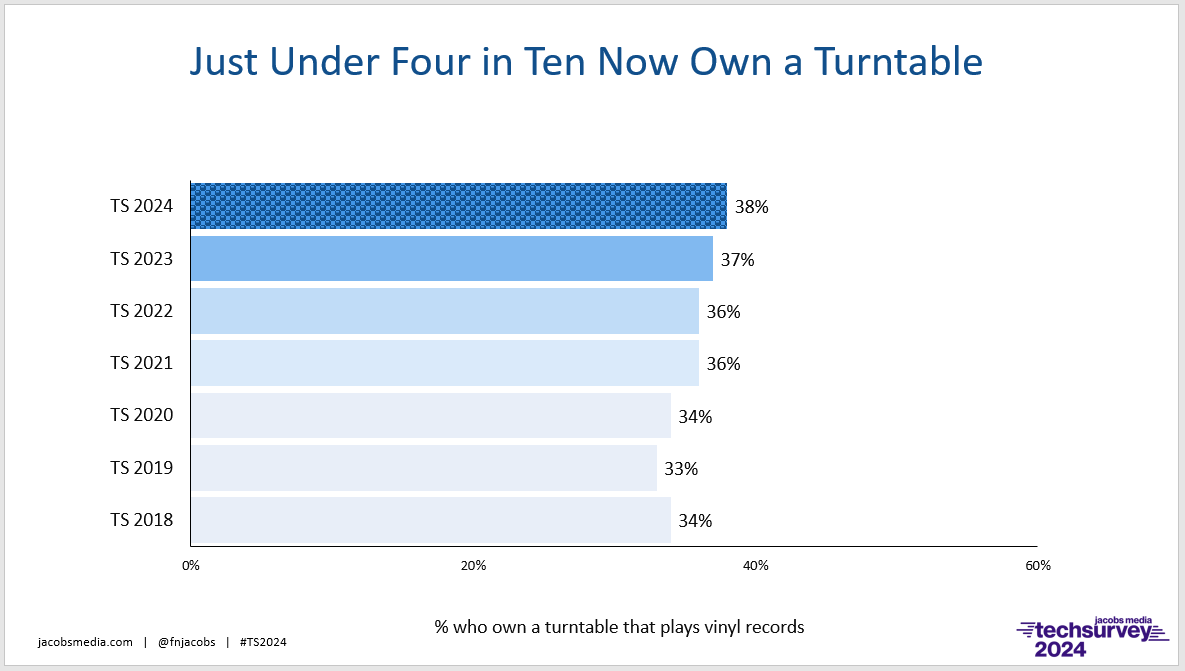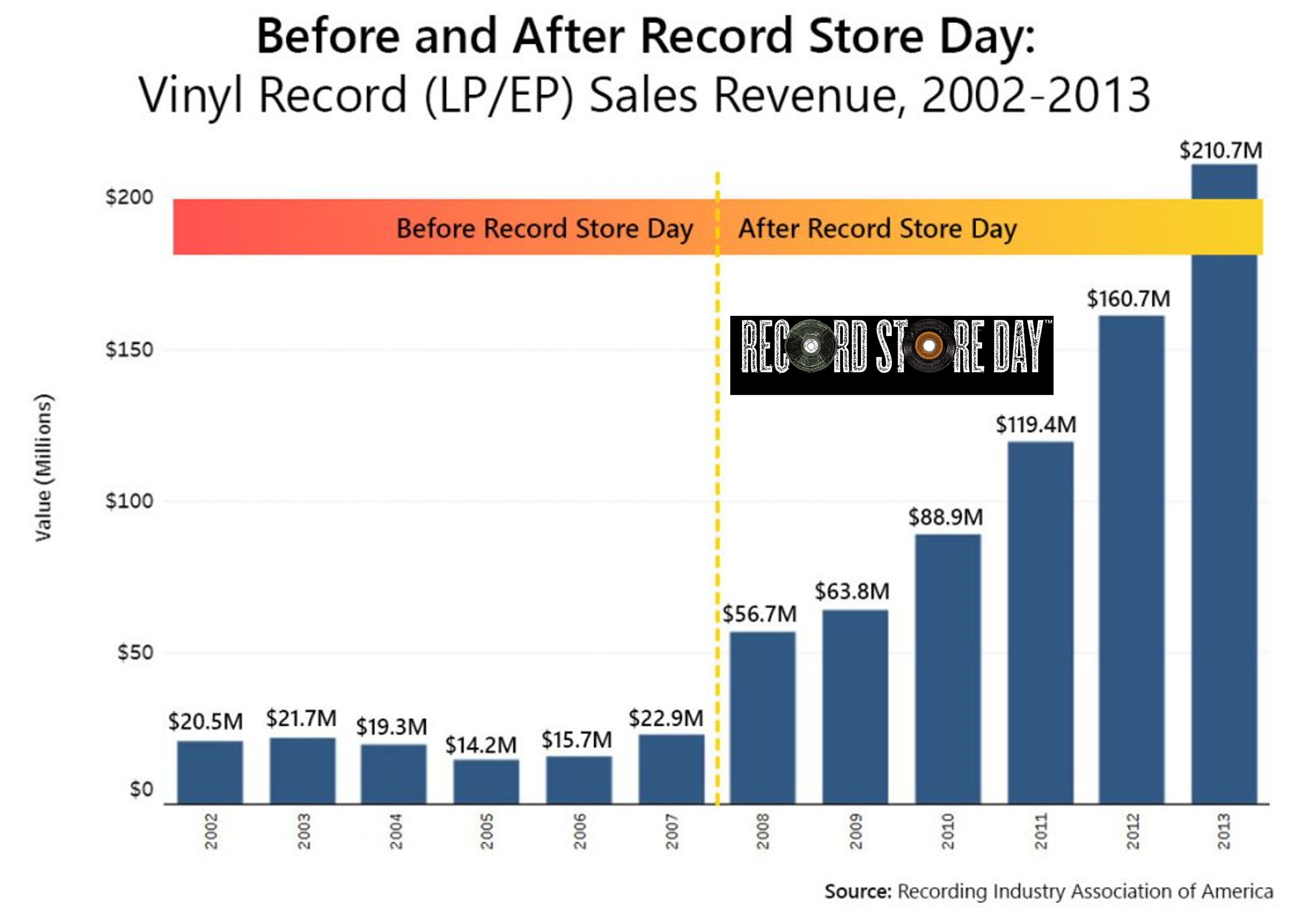(Hypebot) — Vinyl has been a noteworthy subject from its beginning, but since it has come back repeatedly over decades, you cannot help but wonder why. Fred Jacobs goes looking for answers.
by Fred Jacobs of Jacobs Media
It’s the comeback story of the year, maybe of our media lifetimes.
While we’ve been busy uploading millions of songs into hard drives these past many years, and moving our CD collections to the storage room, vinyl records have been on a fantastic journey – from dead as a doornail to alive and well. And it’s all quietly happened over the past 20 years when new media and gadgetry have remade our world.
Vinyl record albums (and 45 rpm singles) boomed in the 1950s and 1960s, then other formats – mostly more portable and playable in cars – gave vinyl a run for its money. As 8-tracks, cassettes, CDs, and of course, mp3 files each became the modern ways to listen to music, vinyl began its fade-out in the 90s.
There were attempts – mostly lame ones – to install record players in cars. Plymouth excited music lovers for a minute with their “Highway Hi-Fi” turntable but drivers soon found them unreliable and more than a little distracting.
How bad did it get for vinyl records? In the early 1990s, sales fell like an anvil – and had no pulse for more than a decade. To say vinyl records were nearly extinct is an understatement.
And then in the early 2000s, the turnaround began. The chart below covering a 25-year period from 1978 until 2002 illustrates one of the most remarkable comeback stories in consumer history. While vinyl is nowhere near back to the levels it enjoyed in the late 70s, it continues to show remarkable growth, re-reaching a billion dollars in sales two years ago.

It’s mind-boggling, and almost unbelievable given our rapid techie trajectory these past two decades.
According to a thorough and fascinating analysis by Camoin Associates, an economic and lead-gen consulting firm, vinyl passed CDs in sales two years back, continuing to blow away all those doomsday predictions from the turn of the century.
How impressive is vinyl’s rebound? In the UK, it is now once again part of the ways in which they measure inflation, right there with the price of petrol, milk, and 742 other market basket items. This marks vinyl’s return to the list for the first time since 1992, according to The Guardian.
If you’re paying attention, you see turntables and stacks of vinyl records showing up in hotel lobbies and lounges, a throwback to bygone days. Unlike the way we listen to digital music – often with earbuds or headphones – vinyl records are most often enjoyed communally over speakers.
That’s the way songs are recorded and albums are mastered – on studio monitors that flow with the ambiance of a room or space. Open-air listening is less confining, allowing the listener to be present rather than isolated.
We noted the shift here in Detroit when Jack White (formerly of the White Stripes) opened a vinyl pressing plant at his Third Man Records facility in midtown Detroit over the Thanksgiving holidays in 2015. I was there that weekend, along with my family, welcoming what has become a a cultural icon in the Motor City. I also wrote a post here not long after, “Radio’s Vinyl Fling.”
Here’s the interesting part – turntable sales have risen during this period, but not commensurate with the explosive growth of vinyl. Our Techsurveys show the same trend – turntables have steadily grown, but nowhere near the meteoric rate we see with vinyl.

A possible explanation: Music Business Worldwide reports on a study by Luminate that “50% of consumers who have bought vinyl in the past 12 months own a record player…”
Of course, that means 50% don’t own a turntable. That stat underscores the trend that vinyl is both nostalgic and a valued collectible.
And that takes us back to the underlying reasons for vinyl’s rebound from its near-death experience, and whether we can take anything away from it.
Camoin Associates’ Jilayne Jordan lists six key factors that appear to have contributed to vinyl’s resurrection, some of which might have implications to radio:
1. Record Store Day – The before-and-after sales figure from 2008 when this event was launched tell a story. We’ve worked with College Radio Day and its “Vinylthon” event that conveniently falls at the same time. All the talk over the radio airwaves has to be a contributing factor in the vinyl story.

2. COVID – Jordan points to share vinyl sales increases once the pandemic got going in early 2020. She reasons consumers were seeking new hobbies and time-killers while spending more time at home. I would add to that the need for “comfort” activities. And for many, listening to your favorite records spinning on the turntable while you’re parked on the couch produces a warm and fuzzy feeling for many, leading us to…
3. Nostalgia – No doubt about it, the superpower of looking back to one’s “good old days” factors into vinyl’s growth. And I think you have to give the nod to Classic Rock, an album-oriented radio format (one of the few) that has drawn attention to vinyl over the years. Could Classic Rock radio stations better leverage this modern trend in listening and collecting?
4. Digital burnout – Jordan points to high-tech devices that consumers are no longer as enamored with – smartphones, earbuds, streaming – all artifacts of the times in which we live. How else can you explain the flip-phone phenomenon? Again, nostalgia is at work here.
5. Collectability – This is an important angle in vinyl’s unlikely rise, and it partially explains Luminate’s data point that half of U.S. buyers don’t even own a turntable. Those vinyl records – especially with shrink wrap still on – might make a great investment. Hopefully, you didn’t purge your collection at a garage sale.
6. Aesthetics – I felt this when the CD was launched in the early 1980s with those nice, neat, and easily stored jewel boxes. But in the process, we lost album art, liner notes, and all the other accoutrements of the classic record jacket.
Back in the day, I was a fan of Roger Dean who created the album art for bands like Yes, as well as the Hipgnosis team that crafted (among others) all the ethereal Pink Floyd artwork for their albums.
When vinyl was on the outs, much of the culture surrounding rock music visuals was sadly lost.
But there may be another key factor at work that Jordana merely glosses over….
7. Taylor Swift – That’s right. Her “1989” release broke all-time weekly vinyl sales records last year. In its first six days, Luminate datashows the album sold a whopping 580,000 copies.
For radio, is there an opportunity here? Clearly, with giveaways. Back in the day, we regularly gave away concert tickets and albums (“win it before-you-can buy-it). Today, vinyl versions of big albums have more cachet than ever.
“All Vinyl Weekends” could move the needle, grab attention, and also give a station more cred. And then there’s the idea of flipping the whole station back to the turntable and records architecture. (What’s next? Cart machines?) I know….this would be a major investment and would perhaps represent more work and expense than the payoff.
But in a “Back To The Future” way, it could provide much-needed attention to a station that commits, as well as reorienting the attention spans of air talent – hopefully in a good way.
And finally, I couldn’t help but wonder as I was writing this post whether some of the same factors that have vaulted vinyl from the ashes could work for radio.
Nostalgia and the back-to-the-basics mindset in a world of algorithms, subscription fees, and streaming could provide the warmth and comfort we associate with vinyl.
Of course, a key difference is that playing “Abbey Road” on a turntable in 2023 sounds as good as it did in 1969 when the album was released.
Does radio today sound as good to consumers today as they remember it from 2000, 1990, or 1980?
I’ll leave that one to you.
P.S. That’s Jim Kerr pictured above, this week celebrating an amazing 50 years doing mornings in New York City. Born and raised in Detroit, Jim has set an incredible example for all of us in radio over the years. We wish him all the best and thank him for bringing class, quality, and commitment to FM radio. – FJ
Fred Jacobs founded Jacobs Media in 1983, and quickly became known for the creation of the Classic Rock radio format. Jacobs Media has consistently walked the walk in the digital space, providing insights and guidance through its well-read national Techsurveys. In 2008, jacapps was launched – a mobile apps company that has designed and built more than 1,300 apps for both the Apple and Android platforms. In 2013, the DASH Conference was created – a mashup of radio and automotive, designed to foster better understanding of the “connected car” and its impact.





























